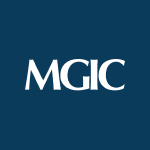MGIC Q4 2020 Earnings Report
Key Takeaways
MGIC Investment Corporation reported a net income of $151.4 million, or $0.44 per diluted share, for the fourth quarter of 2020. Adjusted net operating income (Non-GAAP) was $149.5 million, or $0.43 per diluted share. The company wrote $33.2 billion of new insurance in the fourth quarter, contributing to a more than 10% year-over-year increase in insurance in force.
Net income for the quarter was $151.4 million, or $0.44 per diluted share.
Adjusted net operating income for the quarter was $149.5 million, or $0.43 per diluted share.
New insurance written was $33.2 billion, reflecting the resilience of the purchase mortgage market.
Insurance in force increased by 3.2% during the quarter and 10.9% compared to the previous year.
MGIC
MGIC
Forward Guidance
MGIC is encouraged about the continued resiliency of the housing market, but there is still uncertainty about the timing and pace of the economic recovery and the long-term impact of the governmental and GSE response to aid consumers impacted by the pandemic.
Positive Outlook
- MGIC finished 2020 with strong financial results.
- The housing market has been resilient.
- MGIC wrote $112.1 billion of new insurance in 2020, including $33.2 billion in the fourth quarter.
- Insurance in force increased more than 10% year-over-year.
- MGIC further strengthened its already strong capital and liquidity positions.
Challenges Ahead
- There is still uncertainty about the timing and pace of the economic recovery.
- There is uncertainty about the long-term impact of the governmental and GSE response to aid consumers impacted by the pandemic.
- The economic effects of the COVID-19 pandemic impacted higher losses incurred, especially in the second quarter of the year.
- Persistency was lower due to the strong refinance market.
- Primary delinquency inventory increased due to the adverse economic impact of COVID-19.
